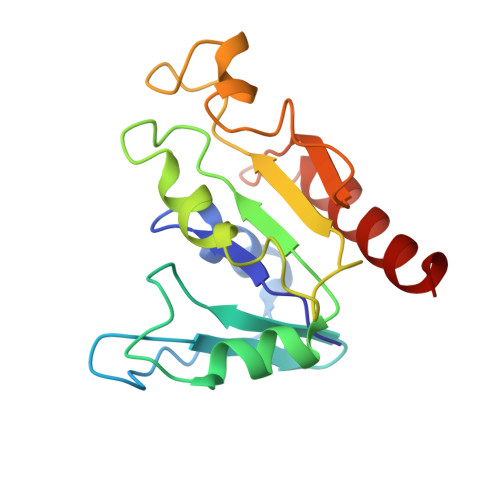Conformational changes in human Arf1 on nucleotide exchange and deletion of membrane-binding elements.
Seidel, R.D., Amor, J.C., Kahn, R.A., Prestegard, J.H.(2004) J Biol Chem 279: 48307-48318
- PubMed: 15308674
- DOI: https://doi.org/10.1074/jbc.M402109200
- Primary Citation of Related Structures:
1U81 - PubMed Abstract:
Conformational changes associated with nucleotide exchange or truncation of the N-terminal alpha-helix of human Arf1 have been investigated by using forms of easily acquired NMR data, including residual dipolar couplings and amide proton exchange rates. ADP-ribosylation factors (Arfs) are 21-kDa GTPases that regulate aspects of membrane traffic in all eukaryotic cells. An essential component of the biological actions of Arfs is their ability to reversibly bind to membranes, a process that involves exposure of the myristoylated N-terminal amphipathic alpha-helix upon activation and GTP binding. Deletion of this helix results in a protein, termed Delta17Arf1, that has a reduced affinity for GDP and the ability to bind GTP in the absence of lipids or detergents. Previous studies, comparing crystal structures for Arf1.GDP and Delta17Arf1.GTP, identified several regions of structural variation and suggested that these be associated with nucleotide exchange rather than removal of the N-terminal helix. However, separation of conformational changes because of nucleotide binding and N-terminal truncation cannot be addressed in comparing these structures, because both the bound nucleotide and the N terminus differ. Resolving the two effects is important as any structural changes involving the N terminus may represent membrane-mediated conformational adjustments that precede GTP binding. Results from NMR experiments presented here on Arf1.GDP and Delta17Arf1.GDP in solution reveal substantial structural differences that can only be associated with N-terminal truncation.
Organizational Affiliation:
Complex Carbohydrate Research Center, University of Georgia, Athens, Georgia 30602-4712, USA.
















